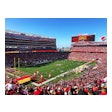Innovations in protective equipment aren’t happening overnight, but the cumulative effect points toward better protection and increased comfort
Manufacturers of protective athletic equipment are finding that technology is helping them come up with better fitting, higher quality products that also offer increased protection.
Better products aren’t appearing on store shelves overnight, however. As much of a friend as they have in technology, manufacturers are only making “incremental” innovations that are “slow and deliberate,” according to Thomas Doyle, director of information and research for the National Sporting Goods Association of Mt. Prospect, Ill.
No Surprises
This should come as no surprise. Preoccupied with liability concerns, many manufacturers are playing their cards very carefully.
“Before they make changes or improvements, manufacturers want to make sure they’re not causing more problems than they’re trying to solve,” says Doyle. “There’s a great deal of reluctance to make changes where there’s a great potential for injuries.”
Even an innovation that looks and sounds good on paper and in the laboratory may cause problems later.
“You can test the equipment on a trial basis,” Doyle says, “but what kind of shape will it be in three years from now when it’s gone through one or two reconditionings or hasn’t been reconditioned at all?”
Another restraint is money. School board and park and recreation department budgets haven’t exactly been generous when it comes to equipment purchases.
“Manufacturers have to live within the restraints of producing something that is affordable,” says Doyle.
Despite liability and cost concerns, several manufacturers are coming out with equipment that, while not exactly changing athletic protection as we know it today, is leading to more comfortable and affordable, yet safer, products.
Time Consuming
Robert Drew, vice president and general manager of Athletic Helmet, a division of Schutt Manufacturing Co. of Litchfield, Ill., disagrees that liability is the overriding reason for the slow rate of innovation.
“We’re always trying to take advantage of changing technologies, but we don’t really let the fear of product liability guide us, because we know we’ve done the best job we could to begin with when we did the research and development,” Drew says. “From the beginning, we strive to make the equipment as protective as we know how.”
What keeps new products from appearing overnight, Drew says, has more to do with the time-consuming nature of the innovation process itself than anything else.
“When new technology comes along,” says Drew, “we review the feasibility for it in our products, and if it looks like a good thing we go ahead and use it.”
Recent innovations at Athletic Helmet have focused on player comfort and equipment fit. An injection molding process has been used to make the front sizers on its helmets softer and prevents them from absorbing perspiration. There also is a softer air liner that provides a better fit, while maintaining comfort, and a more comfortable nose bumper.
Each innovation was the result of an extensive research and development effort.
“we make sure that any change we make is not only thoroughly tested in the lab, but, subsequently, also in the field,” says Drew. “We run a lot of field tests and a number of universities and other schools are helping us make these tests.
“We also make sure that if a proposed change won’t improve the performance of the product, that at least it won’t compromise or reduce the product’s safety or performance.”
Drew says athletes can look forward to “several dramatic changes” in Athletic Helmet products in the coming years, though he declined to specify what those changes will be. “We’re really excited about them,” says Drew. “Some of them are on the boards right now.”
The “engineering oriented” Riddell Inc. of Chicago, according to Ed Tobergte, the company’s vice president of sales and marketing, also has focused on comfort and fit with the introduction of its VSR (variable size range) air suspension helmets for 1988.
The VSR line is designed to fit a maximum number of players with a minimum number of shell sizes, while providing optimal fit for individual head size.
The VSR-1, for the high school, college and professional player, has one inflatable bladder in the back. The VSR-Y is a similar version designed for youth leagues.
The VSR-3, also for the high school, college and professional player, has additional bladders in the front and temple sections of the helmet that also but eliminate protection gaps.
Any of the models can be customized with the factory-installed “Denver Front,” an inflatable pad placed under the front bladder that ensures good fit for heads with a sloping brow.
“The helmets are innovative because we’ve been able to take a considerable amount of weight out of them and still keep them very protective,” Tobergte says. “We can get a precise fit utilizing this new air system.”
In combination with the VSR line, Riddel is introducing the lightweight thermoplastic KRA Lite® IV face guards that Tobergte says can withstand the weight of a car, but weigh up to one-half pound less than conventional, similar-sized wire guards. Riddell also has introduced Biolite shoulder pads that are made of an extremely lightweight closed- and open-cell foam. The perspiration-resistant pads have modular replaceable parts instead of the cut-and-glued design of conventional pads.
The Biolite line also features knee, thigh, hip and coccyx pads.
Tobergte agrees with Drew that the product innovation process is a time-consuming one.
“It’s a never-ending, day-to-day effort,” he says, “that combines the latest technology with the hands-on field testing, evaluation and constant refinement to provide optimal protection, customized fit, comfort and improved performance.”
The Next Step
Bike Athletic Co. of Knoxville, Tenn., is expanding its Prolite line of pads for 1988 with an extra-large hip pad that will increase protection of hips and lower ribs, and an extra-long, 9-½ inch knee pad that has a notched hinge for more comfort and flexibility.
Like Bike’s earlier pad lines, the new hip and knee pads use body heat to mold the pad to the player’s individual body contours, resulting in less weight and bulk, but greater protection.
Ed Christman, Bike’s marketing manager of protective equipment, says the new pads “are not a dramatically new deal for us,” because they augment an already successful line of pads.
What is a new deal for Bike is the introduction of a three-quarter-length girdle for 1988 that can house not only hip and thigh pads, but also knee pads, including the new extra-long knee pad.
The three-quarter-length Complete Protection and Support® girdle is a “complete housing system” that helps minimize the risk of injury by securely holding all three pads in place.
“Bike was one of the first companies to develop the girdle system for hip and thigh pads and now we’ve taken the next step so that players can wear all pads in one garment that keeps them in place,” Christman says.
The three-quarter-length girdle will be marketed as a “multisport” piece of equipment that can be used for football, as well as hockey, basketball, baseball, softball and soccer.
Wilson Sporting Goods of Chicago has introduced the Cobra Composite shoulder pads, which provide lightweight, air-cushioned protection.
Kathy Button, Wilson’s manager of public relations, says the new shoulder pads set themselves apart by having a cantilever construction that spreads the point of impact over the entire pad. The bow-shaped cantilever web between the outer and inner sections of the pad helps disperse impact before it reaches the player’s body.
Simple Concept
“The cantilever is such a simple concept,” says Button. “It takes plastic and puts it on plastic, instead of just putting it against the player’s shoulders. The Cobra Composite fits in well with the most important thing we do and that is to try to make different pads for different players.”
The Cobra Compose also features polyurethane open-cell foam that forms an air pocket to transfer air from the point of impact in all directions. By flame-laminating stretch polyester knit lining to lightweight, 1-inch-thick polyurethane foam, an airtight seal provides lightweight, maximum cushioning and prevents perspiration absorption.
“When you’re using air in the padding, it doesn’t add weight like conventional padding does,” Button says. “The game is made more fun by not having all that weight to carry around.”
Riddell’s Tobergte says product innovations, regardless of which company makes them and how quickly they appear, are gradually adding a new dimension to sports.
“It’s been expected for some years that 21st century athletes would be outlined differently than they are now,” Tobergte says. “We’re starting to see some of that come true with the lightweight, more durable materials available and innovations in sizing and fitting.”
This article originally appeared in the November 1987 issue of Athletic Business.
































